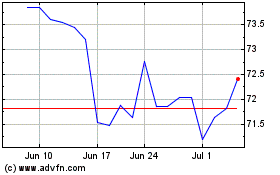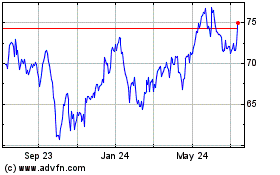West Coast Power Providers Explore EV Charging for Zero-Emission Shipping Along I-5, Connecting Routes
April 18 2019 - 1:14PM
Business Wire
Utilities, municipalities say creating
infrastructure for electric trucks along the corridor will improve
air quality, health in the communities they serve
In California, the transportation sector accounts for nearly 80%
of the state’s air pollution and more than 40% of all greenhouse
gas emissions. Washington and Oregon face similar environmental
challenges, transportation being the largest contributor to air
pollution and greenhouse gas emissions in those states as well.
Today, electricity providers in the three West Coast states
announced that they are working on a solution to significantly curb
those harmful emissions.
Nine electric utilities and two agencies representing more than
two dozen municipal utilities are sponsoring the West Coast Clean
Transit Corridor Initiative, a study to determine how best to
ensure that Interstate 5 — a lifeline of goods transportation that
extends more than 1,300 miles from the Canadian to the Mexican
border — is equipped with sufficient charging to support electric
long-haul trucks.
“Many of the utilities represented in this partnership have
programs to support charging electric vehicles that travel within
our own territories, but for extended shipping and long-haul
trucks, we need solutions that we can apply across utility
territories,” said Caroline Choi, senior vice president of
Corporate Affairs for Edison International and Southern California
Edison, one of the utilities sponsoring the study.
The study will explore how best to provide EV charging on I-5
and its connecting routes for medium- and heavy-duty electric
trucks that are being introduced by several major vehicle
manufacturers, as well as to help determine what role electricity
providers can play in electrifying the corridor. Key locations for
electric truck charging infrastructure will also be identified and
prioritized.
“Big challenges require bold and collaborative solutions, and
climate change is such a challenge,” said Emeka Anyanwu, Energy
Innovation & Resources officer for Seattle City Light, another
study sponsor. “So it is exciting to see such a wide range of
experience and diversity of thinking from our various utilities
being brought to bear to tackle such a critical issue.”
Other initiative sponsors are Los Angeles Department of Water
& Power, Northern California Power Agency, Pacific Gas and
Electric Company, Pacific Power, Portland General Electric, Puget
Sound Energy, Sacramento Municipal Utility District, San Diego Gas
& Electric and Southern California Public Power Authority.
“Well-planned electric charging infrastructure along I-5 is
important to our region,” said Scott Bolton, senior vice president
of External Affairs for Pacific Power. “The I-5 corridor is the
economic backbone for transporting essential goods and services to
our Oregon, Washington and California customers. We see investments
in transportation electrification and electric charging
infrastructure as a great way to support the economic vitality and
environmental quality of communities along the corridor.”
“It’s these types of opportunities that continue to push us
toward a more sustainable future,” said Bill Boyce manager of
Electric Transportation for the Sacramento Municipal Utility
District. “We are proud to partner on a local, regional and
national level to reduce emissions from vehicles, and this effort
to electrify our trade corridors will have significant benefits to
the communities we serve.”
Those benefits include improved health. Data shows that people
who live near truck-traffic corridors experience higher rates of
asthma, lung and heart disease and chronic bronchitis due largely
to breathing toxic vehicle emissions, specifically diesel
particulate matter.
“We are coming together on a regional level and taking the lead,
working across state, county and city lines to take a significant
step to address air pollution and climate change,” said Dave
Robertson, vice president of Public Policy at Portland General
Electric. “We’re preparing for a future in which quiet,
all-electric big rigs haul freight up and down I-5 and its
connected major arteries without releasing pollution or carbon into
the air.”
The study is expected to be concluded by year’s end, with
implementation of recommendations expected to begin as soon as next
year.
About Southern California Edison
An Edison International (NYSE:EIX) company, Southern California
Edison is one of the nation’s largest electric utilities, serving a
population of approximately 15 million via 5 million customer
accounts in a 50,000-square-mile service area within Central,
Coastal and Southern California.
View source
version on businesswire.com: https://www.businesswire.com/news/home/20190418005643/en/
Media Contact: Paul Griffo, (626) 302-2255
Edison (NYSE:EIX)
Historical Stock Chart
From Mar 2024 to Apr 2024

Edison (NYSE:EIX)
Historical Stock Chart
From Apr 2023 to Apr 2024
